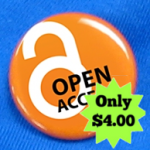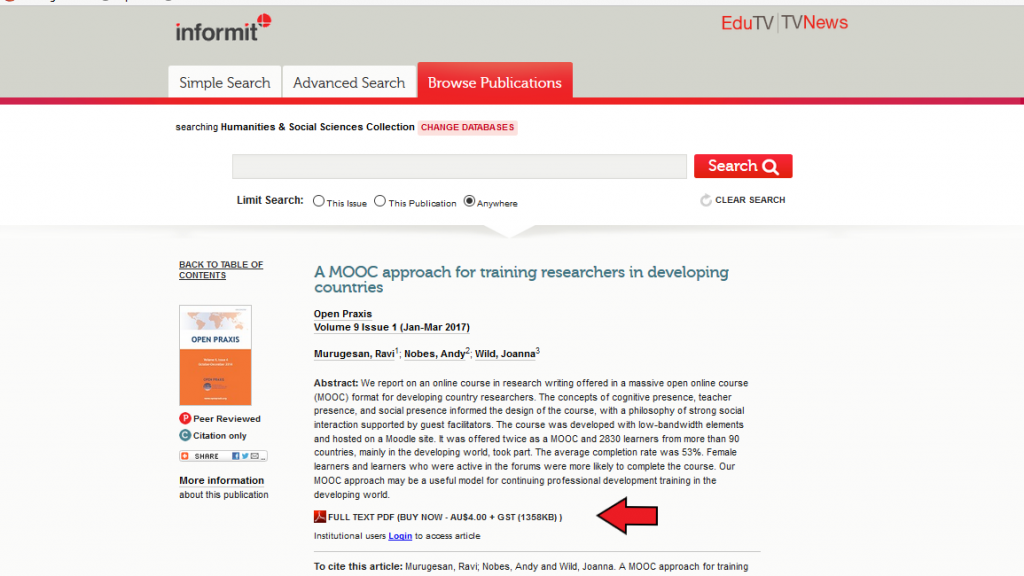When your Open Access paper gets paywalled – part 1
 This year I published my first peer-reviewed paper as a co-author – a report on training developing country researchers using MOOCs. Navigating the co-authoring process with two of my colleagues was certainly a fascinating and character-building journey (and probably worthy of its own blog post) but in the end the paper was accepted after some revisions, and published in the March issue of Open Praxis, the journal of the International Council for Open and Distance Education (ICDE) (full text here). As a bit of an Open Access fan, it was great to be able to publish the paper in a fully Open Access journal which uses the Creative Commons CC-BY 4.0 licence. This ticked all the ‘openness’ boxes and, more importantly, we were confident that this would reach as wide a readership as possible.
This year I published my first peer-reviewed paper as a co-author – a report on training developing country researchers using MOOCs. Navigating the co-authoring process with two of my colleagues was certainly a fascinating and character-building journey (and probably worthy of its own blog post) but in the end the paper was accepted after some revisions, and published in the March issue of Open Praxis, the journal of the International Council for Open and Distance Education (ICDE) (full text here). As a bit of an Open Access fan, it was great to be able to publish the paper in a fully Open Access journal which uses the Creative Commons CC-BY 4.0 licence. This ticked all the ‘openness’ boxes and, more importantly, we were confident that this would reach as wide a readership as possible.
Following the excitement of my first publication, I had been eagerly awaiting our first citation (a little presumptuous, I know), so I thought I would check Google Scholar to see if the paper had any citations yet … and I stumbled upon a curious thing – the default hyperlink for the paper in Google Scholar wasn’t for Open Praxis, but something called ‘search.informit.com.au’.
 I followed the link through to what looked like some kind of Australian library website. And… wait… is that a PAYWALL? Imagine my surprise at seeing a charge of $4 Australian dollars for a copy of the PDF. No link to the journal, no indication that it was Open Access. Just a $4 charge (+tax).
I followed the link through to what looked like some kind of Australian library website. And… wait… is that a PAYWALL? Imagine my surprise at seeing a charge of $4 Australian dollars for a copy of the PDF. No link to the journal, no indication that it was Open Access. Just a $4 charge (+tax).
So how did our openly licensed paper advocating open courses, published in Open Praxis (a journal that champions open educational practices) end up behind a paywall? I had a quick look on the Informit website, which revealed that they are an Australian content aggregator website providing “...information management services to the education, government and corporate sectors“. In fact, the service apparently “…exists to preserve, enhance and distribute hard to find content.“, which is all well and good, but this isn’t hard to find content – our paper is the #2 result in Google Scholar if you search for “MOOC developing countries” in 2017.
I took to Twitter to ask ‘Informit’ what they were up to:
Dear @Informit_RMIT why are you charging AU$4 for our #OpenAccess article on your website? https://t.co/zKlIzvVapv #OA
— Andy Nobes (@andy_nobes) August 15, 2017
I didn’t get an answer at first, by my co-author Ravi Murugesan did (I guess first author status carries more clout!):
.@ICDEOP do you know that @Informit_RMIT is selling OA articles published in your journal? Eg, https://t.co/qVVLibw7nX
— ravi (@RaviMurugesan) August 15, 2017
To be fair their response was quick and detailed:
1/4 Everyone can access articles which are available freely via Google + other free web services cc: @andy_nobes
— Informit (@Informit_RMIT) August 15, 2017
2/4 Informit adds value by making OA articles easy to find + retrieve by adding metadata + categorising articles by subject cc: @andy_nobes
— Informit (@Informit_RMIT) August 15, 2017
3/4 Informit is a content aggregator and only includes articles with publisher permission cc: @andy_nobes
— Informit (@Informit_RMIT) August 15, 2017
4/4 The OA publishers have agreed to have their content on Informit by signing a licence cc: @andy_nobes
— Informit (@Informit_RMIT) August 15, 2017
There are some fair points here. Yes, the paper is available free online, but for some inexplicable reason one of those sources links to their ‘added value’ paywalled version, and gives no other options to access the paper.
And it’s fine for them to add metadata and categorise articles by subject, but that’s also what academic journals do. For example Open Praxis.
And about this ‘added value’ they are providing. It certainly isn’t adding value for us, and for those who stumble upon this page by accident. It is adding some value for Informit though, or as Ravi remarks:
I suppose not linking to the original source where the full text is available free of cost is also part of how you ‘add value’
— ravi (@RaviMurugesan) August 16, 2017
With regards to the licence, I’m guessing they mean the creative commons licence the article/journal published with. But it’s the author who owns the copyright, under Creative Commons, as Ravi points out:
.@Informit_RMIT, authors retain copyright on @ICDEOP articles. So pull down this article which I’ve authored https://t.co/7yHRWIueFX
— ravi (@RaviMurugesan) August 16, 2017
However, having said this, the copyright holder may not have the right to ask for the content to be removed. The CC-BY licence allows other users to more-or-less do whatever they like with the content as long as the creators of the work are credited, or in the words of the licence itself, “The licensor cannot revoke these freedoms…”.
But is this reasonable, fair use of the material?
There were differing views on Twitter:
Not a good move! Open access is exactly that- open!
— Helen Driver (Bailey (@hvdriver) August 16, 2017
Certainly not. https://t.co/9G1S14q3GJ
— ⓪ Grⓐhⓐm Steel 🔬🎓 (@McDawg) August 16, 2017
Why unethical? surely the point of CCBY is so anyone can REuse for any £purpose? (so long as free at source) see https://t.co/3NmSjDmtoI
— pippa smart (@pippasmart) August 18, 2017
Pippa’s example is the really interesting, similar-ish case of the enterprising ‘who repackaged a collection of World Health Organisation research papers and sold it as a book on Amazon. Because the works were licensed as CC-BY, this is perfectly legitimate and legal, even if the WHO aren’t particularly happy about it.
The WHO would undoubtedly have been able to prevent this by adding an NC clause. But would we have been able to prevent the paywalling of our paper via this means? (More about this in part 2). We didn’t have much time to ponder on this, because…
Success!
After the negative public feedback, Informit decided to back down and un-paywall our paper
We’ve rectified this and the article has been removed from Informit as requested. @ICDEOP is also now fully available as OA on Informit.
— Informit (@Informit_RMIT) August 17, 2017
So the whole of the Open Praxis journal is now fully OA with no paywalls for Informit. Whether this was due to Ravi’s request or bad press, we aren’t sure. Informit backed down before we got the chance to test out a). the boundaries of legality and ethics of this kind of usage, and b). the rights of the copyright holder once his/her work has been published via CC-BY.
Some problems remain, however – Google Scholar still points to the Informit version, which is an issue we will have to take up with them. Why did Google Scholar prioritise a commercial Australian aggregator website over the original, open source? This is potentially a very troubling precedent.
Also, Informit appears to have removed the whole issue of Open Praxis that our article was published in, so the Google Scholar link is hitting a ‘page not found’ 404 page, which is still going to prevent people from getting to the paper.
We’ll continue to work on fixing this, but in the meantime, this has got me rethinking the value of Creative Commons clauses (NC and ND) – more in part 2 of this blog post…

